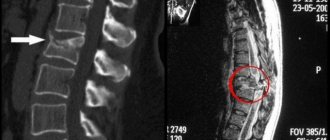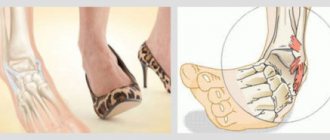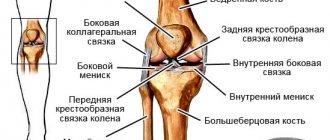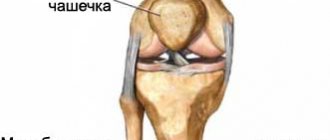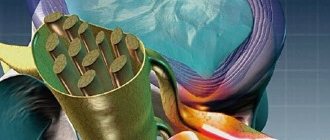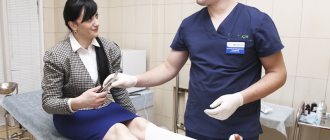There are literally only a few people who have not injured their nose at least once in their lives. This is due to the fact that the nose is the most prominent part of the face.
Author:
- Chuprikov Roman Sergeevich
ENT pathology expert
3.67 (Votes: 3)
There are literally only a few people who have not injured their nose at least once in their lives, since it is the most protruding part of the face.
Anatomy of the external nose
The external nose has a complex anatomy, being an organ with a cartilaginous and bony skeleton, covered with thick skin. It consists of the following sections: the root (the area between the brow ridges), tapering downwards and turning into the pyramid - part of the bony skeleton of the nose, represented by the nasal bones and the frontal processes of the upper jaw.
In the pyramid, there is a back - a face facing outwards, and slopes - the side surfaces of the pyramid. The tip of the nose is the most protruding part, represented by a cartilaginous skeleton. The tip consists of several cartilages: large and small alar cartilages, lateral cartilages (also called triangular) and quadrangular septal cartilage. All these cartilages are paired, with the exception of the quadrangular one. The cartilaginous section also includes: the wings of the nose, which form the respiratory openings, the nostrils and the collumella - the fold of skin between the nostrils.
The wings of the nose are covered from the inside with skin overgrown with dense bristly hairs; they form the vestibule of the nasal cavity, which passes into the cavity itself. The skin of the tip is very tightly fused with the underlying cartilage; in the bony part, the skin lies on loose subcutaneous tissue and is easily displaced. Between the skin and cartilage there are facial muscles, thanks to which we can wrinkle our nose, flare our wings, raise and lower the tip, which serves as a demonstration of emotions. The blood supply to the nose is very good. It comes from the system of external and internal carotid arteries. Venous outflow goes both to the internal jugular vein system and to the cranial cavity. Innervation is carried out by the branches of the trigeminal nerve.
How to distinguish a fracture from a bruise?
What do you need to know about this? Many people are interested in how to identify a broken nose or bruise. In this case, the signs are quite similar to each other. However, there are some distinctive features. For example, if the nose is only injured and there is no fracture, then swelling will appear only along the edge of the damaged organ. Painful sensations from bruises are quite tolerable. If the bone is damaged, the pain becomes unbearable, and the patient may even go into shock. Bleeding from a bruise is not so severe and can be easily stopped using special compresses and vasoconstrictor drops. The symptoms of a broken nose and a bruised nose are similar. However, in case of bone damage, the clinical picture will be more pronounced.
- Nose fracture: symptoms, how to find out if the nose is broken, treatment, consequences
Main function of the nose
The main function of this organ is respiratory, but aesthetic and communication functions will also be important. Scientific studies have been conducted that have revealed that people recognize each other by the shape and size of the nose, as well as by its proportions relative to other parts of the face. Thus, it is one of the most important signs of objective individuality.
Different races have their own characteristics of the structure of the external nose:
- Slavic - a relatively small bone part and a more developed cartilaginous section;
- Greek or Roman - distinguished by a long, narrow pyramid of the nose, often with a hump and a relatively small cartilaginous section;
- Caucasian - large bone and cartilaginous part, often with a hump;
- negroid - characterized by a small bony part and a large, usually flattened tip with wide wings;
- Asian - distinguished by proportionally small bone and cartilaginous parts, often with a flattened back and tip.
One of the features of our olfactory organ is that it grows throughout our lives, changing with age. This is especially true for the nasolabial angle. In children, the nasolabial angle is usually obtuse, about 105 degrees; in adults, it approaches a rectangular angle; in older people, the tip often drops and the angle becomes acute.
Causes
A nasal fracture in a child can occur under the influence of the following factors:
- falling from height;
- injury in a road accident;
- careless handling of household appliances;
- injury caused by a blow during active pastime or while playing sports;
- when falling due to fainting caused by hypertension or exhaustion;
- injury as a result of a fight;
- being hit on the nose by a door or swing;
- using toys that are not suitable for age.
It is important to know that if a child is struck in the nose area, an open fracture may occur. It may be characterized by damage to the paranasal sinuses.
Injuries
There is no need to dwell on the mechanism of nasal injury - it is understandable. The mildest injuries are bruises and abrasions; they do not carry serious consequences and quickly pass without treatment. Antiseptics should be used to treat abrasions, as abrasions can become inflamed, which can cause infection of the skin and other tissues. For wounds of the external nose, they are treated with antiseptics and sutured.
Stitches are usually left in place for 7 days. For deep wounds with cartilage damage, the cartilage is first sutured, if possible through the perichondrium, and then the skin is sutured. Wound treatment is carried out in a gentle manner, and suturing is carried out in a cosmetic way, in order to maintain a good cosmetic effect in the future.
Fracture of the nasal bones
It occurs rarely in children, especially at an early age. This is due to the fact that the bony pyramid in children is small, and the cerebral part of the skull is more developed than the facial part, so the blow falls on the frontal area, which “protects” the olfactory organ from fracture. But fractures still happen.
Symptoms of a fracture requiring medical intervention:
- deformation of the nose (it may move to the side, the back or one of the slopes may become retracted);
- difficulty in nasal breathing (this can occur due to swelling of the mucous membrane or the formation of a septal hematoma);
- nosebleeds (if it is intense and prolonged, then it needs to stop);
- prolonged nasal discharge (very rare, but after trauma to the nose and facial bones, nasal liquorrhea occurs - the leakage of cerebrospinal fluid from the nasal cavity. This occurs due to a fracture of the bottom of the anterior cranial fossa and rupture of the dura mater).
Fractures often occur without displacement, which does not require additional treatment; it is enough to maintain mechanical rest of the damaged organ. Often, a patient consults a doctor when there is severe swelling of the soft tissues, and it becomes difficult to assess the degree of deformation. In such cases, it is recommended to wait until the swelling subsides, about 5-7 days. The deformity is assessed primarily clinically, even if a fracture is clearly identified on an X-ray or CT scan, and the nose is straight, without signs of deformation—reposition is not required.
Repositioning of the nasal bones
What is the time frame for repositioning? There is an early reposition, when swelling of the soft tissues has not had time to develop, this is the first 6-12 hours, and a late one, after the swelling has subsided, on days 5-7. The nasal bones can be realigned in up to three weeks. After reposition, their fixation is required; for this, tamponade is performed and a plaster or adhesive fixing bandage is applied.
The nasal tamponade is left for 3-5 days. Tampons cause noticeable discomfort, but they are still preferable because they support the nasal bones from the inside and also have hemostatic properties. After removing the tampons, you need to be observed by a doctor for some more time, since after tamponade the formation of synechiae (scar adhesions) in the nasal cavity is possible.
Reduction and tamponade are difficult to achieve in children. Due to fear and reluctance to participate in unpleasant procedures, for children, if necessary, the operation is performed under anesthesia.
Subluxation of the quadrangular cartilage
With nasal injuries, subluxation of the quadrangular septal cartilage often occurs. With this injury, as a rule, the lower parts of the cartilage are torn from the bottom of the nasal cavity. This injury is rarely diagnosed because it is not always clear whether the septum was previously deviated. Subluxation of the quadrangular cartilage can occur together with a fracture or independently.
Symptoms of this injury are nosebleeds, septal hematoma, changes in the position of the septum and collumella, and increased mobility of the quadrangular cartilage. The quadrangular cartilage is not reduced because it is difficult to fix. If the septum is deformed and nasal breathing is impaired, septoplasty is performed - surgical correction of the curvature of the nasal septum.
Almost all cases of deviated septum in adults are associated with trauma to the quadrilateral cartilage in childhood. Even minor trauma can result in rupture of the perichondrium or disruption of the connections of the quadrangular cartilage to surrounding structures.
Nosebleed due to injury
Occurs when the vessels of the nasal septum are damaged or when bones are broken with rupture of the skin and mucous membrane in the nasal cavity. Depending on the diameter of the vessel and the clotting ability of the blood, bleeding can be profuse, prolonged and lead to significant blood loss.
The main way to stop nosebleeds is with tamponade for several days. Sometimes, if the source of bleeding is clearly visible, electrocoagulation of the bleeding vessel is possible.
Hematoma of the nasal septum due to trauma
It occurs when blood vessels rupture in the thickness or under the mucous membrane of the septum, and blood, leaving the vascular bed, peeling off the mucous membrane, forms a cavity filled with blood. It may be on one side or both. Hematoma of the septum can accompany a fracture of the nasal bones, subluxation of the quadrangular cartilage, or occur independently.
The main symptom is difficulty in nasal breathing, which does not improve over time or by taking vasoconstrictor drops. Upon examination, a sharp thickening and cyanosis of the septum are determined; when pressing on the mucous membrane, its pliability is determined, with the adoption of the previous form - fluctuation.
Treatment of hematoma
In the first hours, a puncture of the cavity is performed and the blood is aspirated with a syringe, followed by anterior tamponade. After 9-12 hours or later, an incision is made along the front edge of the hematoma and the cavity is cleared of blood, since clots have already formed and it is not possible to aspirate them with a syringe. A graduate is placed into the incision and anterior tamponade is performed.
Subsequently, the nasal cavity is subjected to care several more times. A frequent complication is the development of suppuration of “old” blood with the formation of a septal abscess, so it is recommended to treat all hematomas.
Foreign bodies
Injuries to the olfactory organ can also include foreign bodies. This happens especially often in children, who, while playing, can stick various objects into their noses. Often parents do not know about this, but after some time they notice that the child cannot breathe in one nostril (much less often two) and a liquid with an unpleasant odor is released from it. The depth of the foreign body varies; it can be the vestibule of the nasal cavity or the cavity itself.
Sometimes foreign bodies can remain in the nasal cavity for years, gradually becoming overgrown with mineral layers of mucus, which forms rhinoliths, which can remain there for decades. If a foreign body is suspected, an examination by an ENT doctor is required with endoscopy, and sometimes a computed tomography scan of the paranasal sinuses.
Symptoms
To understand whether a child’s nose is broken, you need to know what primary and secondary signs characterize this condition.
The main ones include:
- painful sensations in the organ, especially upon palpation;
- a characteristic crunching sound may be heard;
- mucous discharge from the sinuses;
- bleeding of varying degrees of intensity;
- nausea, dizziness, possible vomiting;
- state of shock, fainting is possible;
- You can feel the mobility of the nasal septum.
Secondary signs include:
- severe swelling of the nose;
- the presence of bruises under the eyes, on the cheekbones, around the nose;
- possible injury to the integrity of the skin;
- development of a hematoma on the septum, complicating normal breathing;
- the shape of the nose is deformed.
In addition, parents should know what the signs of a nasal fracture in a child are in the event of an infection:
- hyperemia of the area near the nose;
- increased swelling of the skin near the nose;
- hyperthermia;
- the beginning of tissue softening, an abscess begins.
For clarity, I provide you with a photo of a broken nose:
Nose fracture
